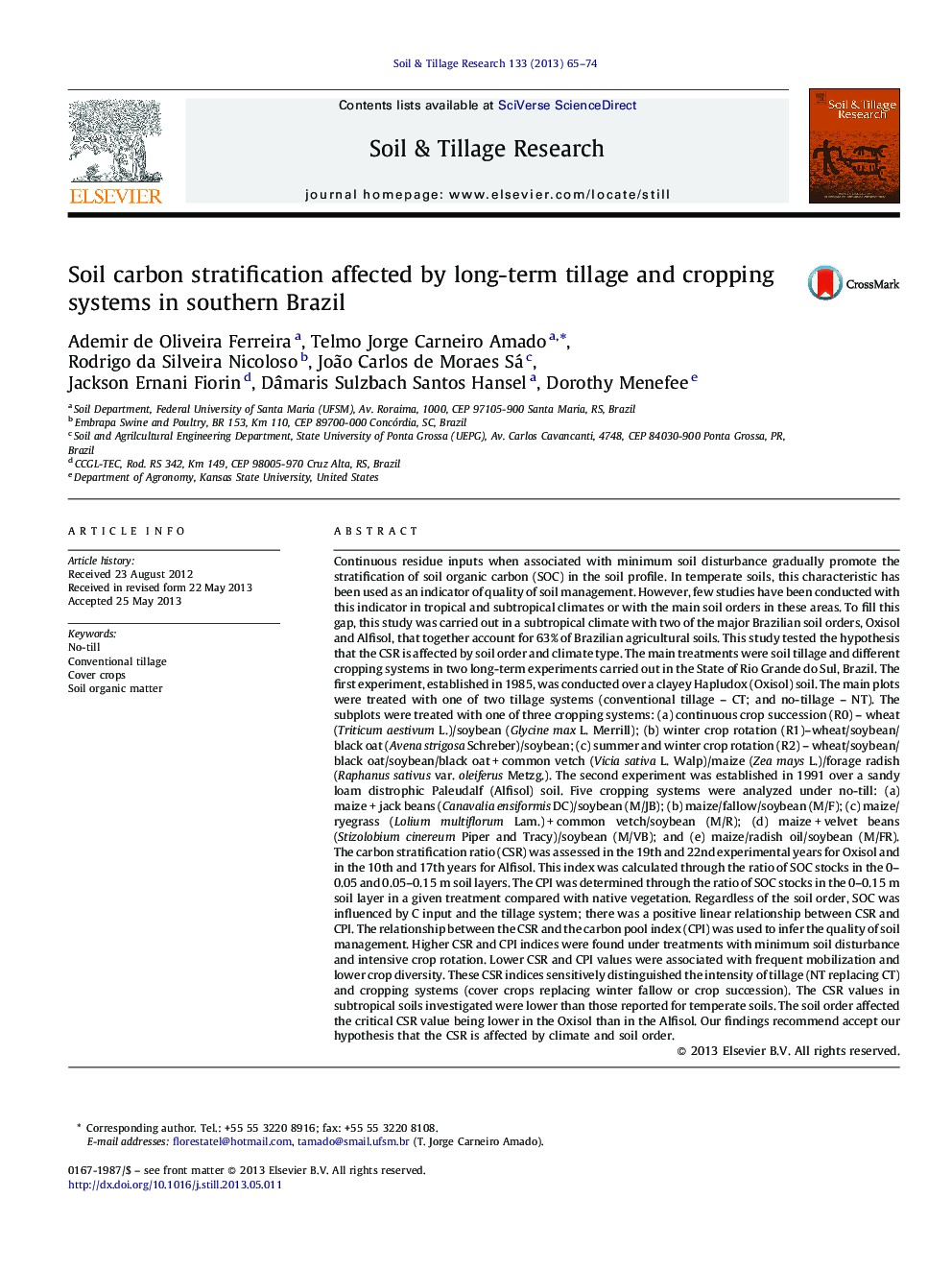| کد مقاله | کد نشریه | سال انتشار | مقاله انگلیسی | نسخه تمام متن |
|---|---|---|---|---|
| 6773565 | 513053 | 2013 | 10 صفحه PDF | دانلود رایگان |
عنوان انگلیسی مقاله ISI
Soil carbon stratification affected by long-term tillage and cropping systems in southern Brazil
ترجمه فارسی عنوان
طبقه بندی کربن خاک تحت تأثیر سیستم های کشت و زراعی بلند مدت و برداشت محصول در جنوب برزیل
دانلود مقاله + سفارش ترجمه
دانلود مقاله ISI انگلیسی
رایگان برای ایرانیان
کلمات کلیدی
خیر خاکستر متعارف، پوشش محصولات ماده آلی خاک،
موضوعات مرتبط
مهندسی و علوم پایه
مهندسی انرژی
انرژی های تجدید پذیر، توسعه پایدار و محیط زیست
چکیده انگلیسی
Continuous residue inputs when associated with minimum soil disturbance gradually promote the stratification of soil organic carbon (SOC) in the soil profile. In temperate soils, this characteristic has been used as an indicator of quality of soil management. However, few studies have been conducted with this indicator in tropical and subtropical climates or with the main soil orders in these areas. To fill this gap, this study was carried out in a subtropical climate with two of the major Brazilian soil orders, Oxisol and Alfisol, that together account for 63% of Brazilian agricultural soils. This study tested the hypothesis that the CSR is affected by soil order and climate type. The main treatments were soil tillage and different cropping systems in two long-term experiments carried out in the State of Rio Grande do Sul, Brazil. The first experiment, established in 1985, was conducted over a clayey Hapludox (Oxisol) soil. The main plots were treated with one of two tillage systems (conventional tillage - CT; and no-tillage - NT). The subplots were treated with one of three cropping systems: (a) continuous crop succession (R0) - wheat (Triticum aestivum L.)/soybean (Glycine max L. Merrill); (b) winter crop rotation (R1)-wheat/soybean/black oat (Avena strigosa Schreber)/soybean; (c) summer and winter crop rotation (R2) - wheat/soybean/black oat/soybean/black oat + common vetch (Vicia sativa L. Walp)/maize (Zea mays L.)/forage radish (Raphanus sativus var. oleiferus Metzg.). The second experiment was established in 1991 over a sandy loam distrophic Paleudalf (Alfisol) soil. Five cropping systems were analyzed under no-till: (a) maize + jack beans (Canavalia ensiformis DC)/soybean (M/JB); (b) maize/fallow/soybean (M/F); (c) maize/ryegrass (Lolium multiflorum Lam.) + common vetch/soybean (M/R); (d) maize + velvet beans (Stizolobium cinereum Piper and Tracy)/soybean (M/VB); and (e) maize/radish oil/soybean (M/FR). The carbon stratification ratio (CSR) was assessed in the 19th and 22nd experimental years for Oxisol and in the 10th and 17th years for Alfisol. This index was calculated through the ratio of SOC stocks in the 0-0.05 and 0.05-0.15 m soil layers. The CPI was determined through the ratio of SOC stocks in the 0-0.15 m soil layer in a given treatment compared with native vegetation. Regardless of the soil order, SOC was influenced by C input and the tillage system; there was a positive linear relationship between CSR and CPI. The relationship between the CSR and the carbon pool index (CPI) was used to infer the quality of soil management. Higher CSR and CPI indices were found under treatments with minimum soil disturbance and intensive crop rotation. Lower CSR and CPI values were associated with frequent mobilization and lower crop diversity. These CSR indices sensitively distinguished the intensity of tillage (NT replacing CT) and cropping systems (cover crops replacing winter fallow or crop succession). The CSR values in subtropical soils investigated were lower than those reported for temperate soils. The soil order affected the critical CSR value being lower in the Oxisol than in the Alfisol. Our findings recommend accept our hypothesis that the CSR is affected by climate and soil order.
ناشر
Database: Elsevier - ScienceDirect (ساینس دایرکت)
Journal: Soil and Tillage Research - Volume 133, October 2013, Pages 65-74
Journal: Soil and Tillage Research - Volume 133, October 2013, Pages 65-74
نویسندگان
Ademir de Oliveira Ferreira, Telmo Jorge Carneiro Amado, Rodrigo da Silveira Nicoloso, João Carlos de Moraes Sá, Jackson Ernani Fiorin, Dâmaris Sulzbach Santos Hansel, Dorothy Menefee,
